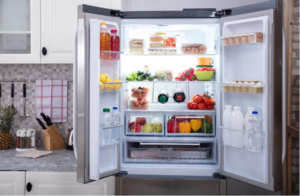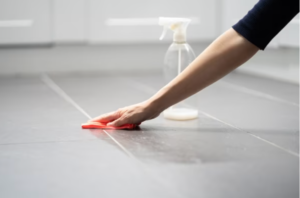
How to Deep Clean an Oven: A Complete Guide
How to Deep Clean an Oven: A Complete Guide A sparkling clean oven not only looks great but also ensures better-tasting meals and prolongs the appliance’s lifespan. This comprehensive guide will help you deep clean your oven efficiently, including recommendations for top cleaning products and handy tips. Essential Tools and Materials Before you start, gather everything you’ll need to make the process smooth and hassle-free: Rubber gloves: Protect your hands from harsh chemicals and grease. Scrubbing pads or sponges: For scrubbing away stubborn grime. Microfiber cloths: Perfect for wiping and polishing surfaces. Plastic scraper: To remove burnt-on residue without scratching. Baking soda: A natural, non-toxic cleaner. White vinegar: Excellent for breaking down grease. Oven cleaner spray: For heavy-duty grime removal (recommended products listed below). Brush or toothbrush: For cleaning tight crevices. Trash bags: For disposing of food debris and paper towels. Bucket or bowl: To mix homemade cleaning solutions. Preparing the Oven for Cleaning Preparation is crucial to ensure safety and effectiveness. Follow these steps: Turn off the oven: Ensure it’s completely cool and unplug it if possible. Remove oven racks and trays: Take out all detachable parts and set them aside. Lay down protective layers: Place newspapers or old towels around the oven to catch drips or spills. Ventilate the kitchen: Open windows or turn on a fan if you’re using chemical cleaners. Cleaning the Oven Racks Oven racks often accumulate baked-on grease and grime. Clean them separately for the best results: Soak in warm soapy water: Fill a bathtub or large sink with hot water and add dish soap or baking soda. Submerge the racks for at least 30 minutes. Scrub thoroughly: Use a scrubbing pad or toothbrush to remove softened grime. Rinse and dry: Rinse with clean water and let them dry completely before reinserting. Applying a Cleaning Solution Assuming you do not have access to professional cleaning solutions, like the ones we use at Scrubs Cleaning, there are many good over-the-counter detergents that can be used for professional looking results. Best Commercial Oven Cleaners: Oven Pride: Recommended by Scrubs Cleaning. Weiman Oven & Grill Cleaner: Gentle but effective on tough stains. HG Oven, Grill and BBQ Cleaner: A more expensive but very effective option. Mr. Muscle Oven Cleaner: Ideal for burnt-on food residue. Homemade Option: If you prefer a more natural, eco-friendly solution, mix half a cup of baking soda with a few tablespoons of water to create a paste. It’s non-toxic, effective, and safe for most surfaces. Apply generously: Spread your chosen cleaner or baking soda paste over the interior surfaces, avoiding heating elements. Let it sit: Allow it to sit for at least 20-30 minutes or overnight for stubborn stains. Scrubbing and Wiping Once the cleaner has done its job, it’s time to scrub away the grime: Use a scraper: Gently remove softened residue with a plastic scraper. Scrub corners and crevices: Use a brush or toothbrush to tackle hard-to-reach spots. Wipe with a damp cloth: Remove loosened grime and cleaner residue using a damp microfiber cloth. Repeat if necessary: For particularly tough stains, reapply the cleaning solution and repeat the process. Cleaning the Oven Door The oven door often gets greasy and cloudy from cooking. Here’s how to clean it effectively: Remove the glass panel (if possible): Check your oven’s manual to see if the glass panel can be detached for easier cleaning. Apply cleaner: Use baking soda paste or a glass-safe oven cleaner. Scrub and polish: Use a sponge or cloth to remove grime, then wipe with a damp cloth to avoid streaks. Polish with vinegar: Spray vinegar on the glass and buff with a microfiber cloth for a streak-free shine. Final Rinse and Dry Once the oven is clean, make sure to rinse and dry all surfaces thoroughly: Wipe with clean water: Use a damp cloth to remove any remaining cleaner residue. Dry completely: Use a microfiber cloth to dry all surfaces to prevent streaks or watermarks. Reinsert racks and trays: Once dry, place the clean racks and trays back into the oven. Handy Tips for Oven Maintenance To keep your oven clean for longer, follow these tips: Use oven liners: Place a non-stick liner at the bottom of the oven to catch spills. Wipe spills immediately: Clean up any spills or drips as soon as the oven cools. Regular light cleaning: Wipe down the oven weekly to prevent grime buildup. Cover food: Use lids or aluminium foil when baking or roasting to minimize splatters. Run a self-cleaning cycle: If your oven has this feature, use it periodically to burn off residue. Summary Deep cleaning an oven doesn’t have to be daunting. By gathering the right tools, using effective cleaning products, and following a step-by-step process, you can restore your oven to its pristine condition. Whether you prefer commercial cleaners like Easy-Off or natural alternatives like baking soda and vinegar, the key is allowing the solution time to break down grease before scrubbing. With regular maintenance and these handy tips, you can keep your oven sparkling clean and functioning efficiently for years to come. Feel free to Contact Us if you require a Deep Clean of your house, including appliances.










